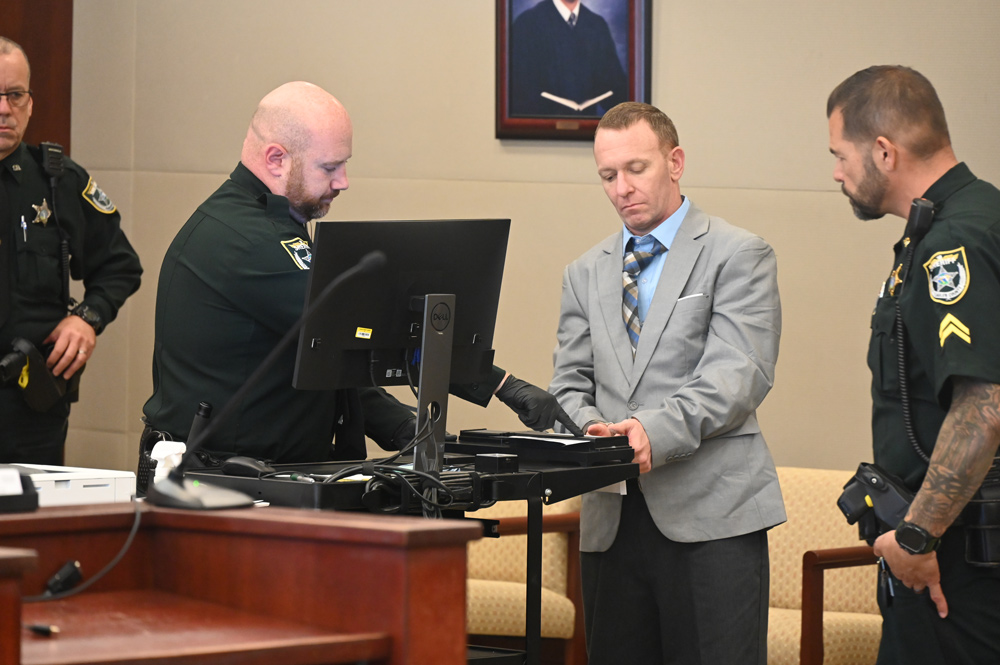
It’s a small urn, only a few inches high. It’s elegantly engraved with silvery leaves on black, though it’s been weathered by time or circumstances, by the repeated touch or cradling of hand or two. It feels disproportionately heavy for its size when you hold it.
The urn contains the ashes of Brian O’Shea, who died in 2022 when he was 38. His mother Maureen O’Shea carried the urn with her all week as she attended the trial of Brian Pirraglia, who called himself O’Shea’s best friend, and who on Feb. 8, 2022, injected his best friend with a fatal dose of fentanyl, then robbed him of the money Maureen had sent her son just two hours earlier. Pirraglia was on trial on a first-degree murder charge coldly referred to, in court parlance, as “first degree murder by unlawful distribution of a controlled substance.”
At 1:30 this afternoon, after deliberating for three hours and 45 minutes, a jury of eight men and four women found Pirraglia guilty as charged. Circuit Judge Dawn Nichols almost immediately sentenced him to life in prison–the first time in Flagler County history that an individual facing that charge is sentenced to life. Many have been charged. Most have pleaded to long but not endless prison sentences. Only three opted for trial. One was acquitted. One was convicted on a lesser charge. Pirraglia alone would up with the maximum penalty.
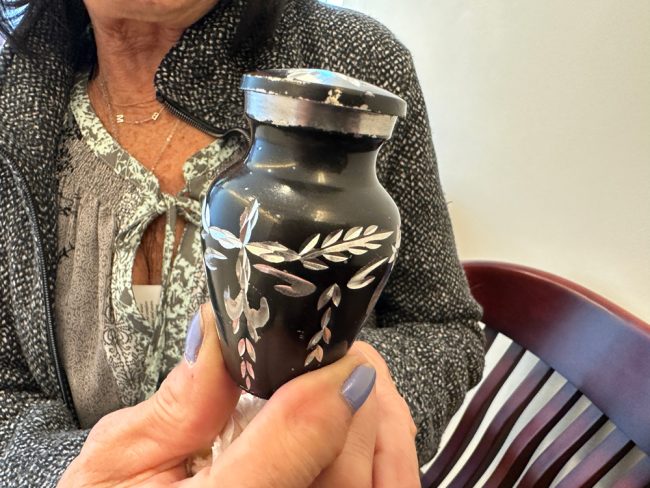
He had sat ramrod, literally holding his breath, as the judge reviewed the jury’s document before handing it to the clerk to be read. The moment Pirraglia heard the word “guilty,” he visibly and dramatically deflated, sat back and shook his head. His facial expression did not change. He did not get emotional. He watched the jury as each juror was polled. He spoke briefly with his attorney, Donna Peterson, who seemed more shocked than he was, asking for an appeal right away.
Maureen O’Shea had sat diagonally from the defendant’s table in the gallery. She sobbed quietly in the arms of Knoeidia Hill, the victim’s advocate with the State Attorney’s Office who’d been with O’Shea all week. O’Shea had flown down from Pennsylvania for the trial, from her home in the Poconos form where she had sent that $800 to her son the day he came out of the Flagler County jail so he could fly home.
“I got justice for Brian, maybe peace for me,” Maureen O’Shea said after the trial. “Did anybody win? No, nobody won. I’m sorry that she–” She didn’t finish the thought: she was referring to Brian Pirraglia’s mother, who had also attended the trial all four days, including jury selection, except today: she had not turned up for the verdict. Maybe she knew, as some in the gallery knew–as they had seen–that the defense hadn’t been much of a defense even if such charges are difficult to prove. “But she could look at her son. I’m never going to look at Brian again. Brian is in my pocket. I carry the ashes with me.” She had dropped the urn once on her toe during the trial. “He made me bleed. I started laughing. I said, you make your mommy bleed.”
Maureen O’Shea, who now runs a grief counseling group called The Ugly Shoes (the trial did not allow much room for her sense of humor), also wanted to set the record straight. “My son suffered substance abuse disorder, and we fought our whole lives,” she said. “Brian Pirraglia is a known drug dealer. He has been a known drug dealer. He was always my son’s person to go to for drugs.” Maureen, who’d lived in Coral Springs for 20 years before returning to Pennsylvania in 2020, had known Pirraglia for those 20 years.
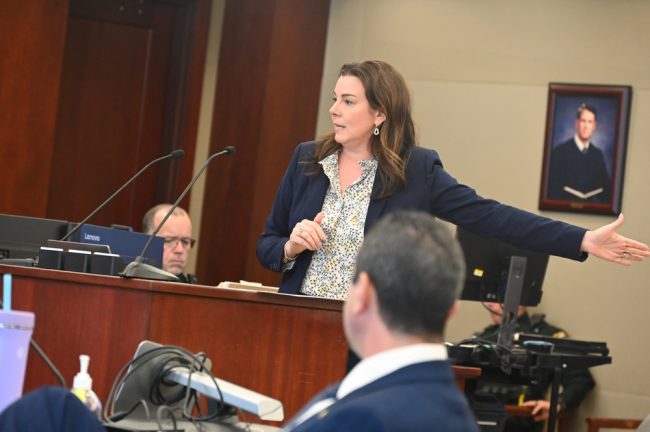
“All you heard was lies from him,” O’Shea said of Pirraglia. “And if you listen to his tapes, all the stories he told was all lies from the get go. From the get go. He wanted my son’s money. That’s all he wanted.” Flagler County Sheriff’s detective Adam Gossett, who investigated the case, had recorded Pirraglia saying many of those lies, claiming O’Shea had fallen, struck his head, had a seizure, that drugs were not involved, that he wasn’t involved–stories that changed when Gossett learned from another drug user who’d just been arrested, and who knew Pirraglia, that took place in Pirraglia’s bedroom on O’Shea’s last day. Pirraglia had told the story to the inmate.
O’Shea had been clean at the jail for six months as he served out a sentence for cocaine possession. But when he was released on what was to be his first day back to freedom, it was Pirraglia who picked him, Pirraglia who took him to Publix to get his mother’s money through Western Union, Pirraglia who took him back to the B-Section drug house where O’Shea had known trouble before, and Pirraglia who, early that very afternoon, took O’Shea into his room and injected him.
Sober for half a year, O’Shea’s tolerance was low. To describe the fentanyl hitting him like a bullet isn’t a metaphor. A bullet would have been no different. He immediately slumped over, struck his head on a marble slab, and never revived. Pirraglia panicked, tried to get Narcan from a roommate sleeping in another room, tried CPR, called 911, but also wheeled O’Shea out of Pirraglia’s bedroom, with all its spoons and powders and lighters, with all its clutter of drugs and recklessness. He locked the door before the cops showed up. O’Shea was taken to the hospital, where he was pronounced deceased.
Peterson’s defense was to cast doubt on every turn on what she termed the prosecution’s “assumptions.” But she cast such a wide net about so many details the prosecution spoke about, and about so many matters that weren’t even in contention, including the detective’s brief time as a detective or the medical examiner’s method or the lurking presence of Pirraglia’s drug dealer, nicknamed Monk, who she implied quite plausibly could himself have sold the drugs to O’Shea. But she could not establish any documented contact between Monk and O’Shea the way Assistant State Attorney Jennifer Dunton, in the very last part of her closing arguments Wednesday, devastatingly proved with video and phone records how Pirraglia had just been in contact with Monk before the fatal dosage.
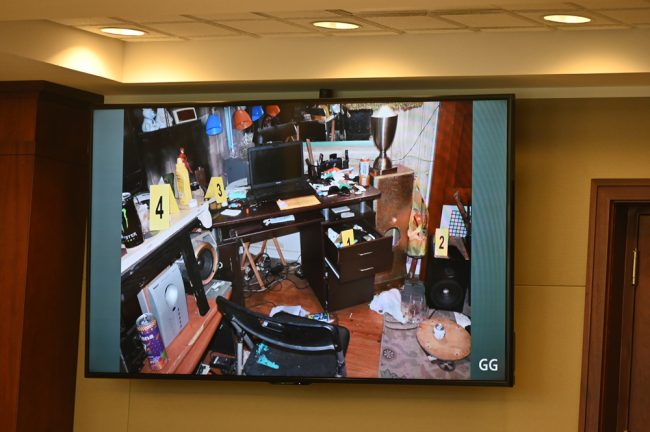
So Peterson’s drizzle of doubt ended up fogging up her case instead of sharpening it, while Dunton repeatedly focused on a few essentials: the very brief timeline between O’Shea’s release from jail and his death, who he was with during those hours and what he did–proven in part by surveillance video at Publix–and what Pirraglia subsequently told two witnesses. That the two witnesses were themselves substance abusers and felons didn’t alter the fact that on the stand, they proved impermeable to more of Peterson’s drizzle. Juries pick up on that.
Peterson showed her by-then soggy cards on On Wednesday in a brief segment of the rial out of view of the jury when she tried to get the recordings of two phone conversations between Pirraglia and O’Shea into evidence. O’Shea was about to be released from jail and had called Pirraglia (all jail conversations are recorded). Pirraglia was telling him about someone who wanted O’Shea sober, though Pirraglia himself, in the judge’s view, sounded impaired. The judge couldn’t understand what the defense was getting at–why Peterson wanted those conversations introduced to the jury. If anything, the conversations would hurt Pirraglia, the judge suggested, since he didn’t sound so clean himself. In the end the conversations stayed out.
Almost two hours into deliberations today, a jury question hinted at the difficulties the panel was struggling with. “Does the meaning of distribution mean,” the question read, “one, the physical exchange of Pirraglia directly giving substance to O’Shea, or two, if the substance is accessible and doesn’t belong to Pirraglia.”
The question indicated that at least some jurors were either confused about how the drugs ended up in O’Shea, or were not convinced that Pirraglia had injected O’Shea with them. Either way, the question was not what the prosecution wanted to hear. If some jurors thought either that the fentanyl wasn’t Pirraglia’s or that Pirraglia hadn’t injected O’Shea, they could not convict.
Dunton, the prosecutor (she tried the case with Assistant State Attorney Jason Lewis), hadn’t left any doubt in her arguments to the jury that Pirraglia had not only acquired the drugs, but had injected them. Neither could be absolutely proved.
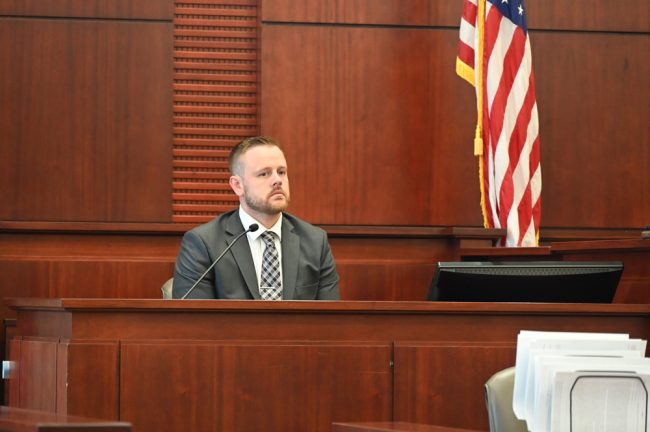
Dunton–trying her last case after a 20-year career, before taking a job in the private sector with a non-profit–relied on circumstances and the tight timeline to make it seem almost unreasonable for a scenario different than Pirraglia acquiring the fentanyl and injecting O’Shea. If in that timeline Pirraglia had been capable of acquiring it, then O’Shea might have been able to do the same. Pirraglia had told authorities that O’Shea had taken a walk outside the house, implying that he could have conducted a drug transaction during that time. But Pirraglia’s credibility was nil, and the defense never focused the jury on that detail, arguing instead that anyone in the house might have been responsible for the drugs. It was more drizzle, as the jury verdict indicated.
“I feel that he’s being punished for something that, to me, he’s messed my son up for 20 years,” Maureen O’Shea said. “In 2020, which they didn’t mention, he put my son in a mental institution for almost a year. I told him then, stay away from my son, or you’re going to be in trouble. My son somehow got back to him.”
Marica O’Shea is Brian’s younger sister–his only sibling. A resident of Pompano Beach, she, too, attended the trial with Maureen and other members of the family. She was prepared to speak her victim’s impact statement to the court had there been a sentencing hearing, but didn’t get the chance. She shared it: “I went into this trial with compassion and empathy for the defendant,” Marica O’Shea wrote. “I know who my brother was, I am also in recovery (God willing I will have 5 years sober next month), and I work in treatment as a primary therapist down in Delray Beach. But after what came out over the last couple of days, I believe wholeheartedly that my brother received justice for the defendant’s complete lack of respect for human life.
“I was appalled and downright furious while I watched him tell bald-faced lies to the first responders who tirelessly fought to save my brother. Not only do I believe in my heart of hearts that the defendant shot my brother that fatal dose, but I believe he carelessly wheeled him out to the living room while conjuring up a bogus story to tell law enforcement and ultimately let him die. The absolute least the defendant could have done was advise first responders to administer Narcan, and he didn’t. Although no one in my family will ever truly get closure, nor get my brother back, at least the defendant can no longer put other families through the hell he has put mine through.”
Corrections: An earlier version of this article reported that Maureen O’Shea lived in palm Coast for 20 years; she had in fact lived in Coral Springs. The reported number of jurors was also corrected.
![]()





























Jay Tomm says
Not saying he doesn’t deserve it, but it’s a personal choice to do drugs. To sentence someone to life for their choice, while others get slaps on wrists for other crimes shows a wide gap of applied justice.
PJP says
There was no evidence or witness to the allegation. Testimony of 2 lying addicts with drug felony charges, one with trafficking and pending DIH (Drug Induced Homicide/capital murder) charges. One scored a deal on his charges.
They indict all over the country with this, carries a mandatory sentence w/o parole.
This new legislation is injustice! Beware! Case going to appeal.
Take a good look says
First of all I want to emphasize that I understand and am sensitive to both sides of this issue. I have worked in the field of addictions as a therapist for years, AND I also have a family member who is serving prison time for the same charge. I also have a nephew who my dear sister found dead in his bedroom from a fentanyl overdose. Understandably so her whole world was shattered. I also have a family member who is currently struggling with addiction. One thing for certain is there can’t be a supplier without an addict, and most often the supplier is also an addict. It’s a twisted symbiotic relationship between the two. These two men suffered from the disease of addiction. On a different day this could very well have been Pirraglia who overdosed and died. Addicts aren’t “ bad people” although as we know they frequently engage in the most awful behaviors fueled by their addictions. The fact of the matter is that these two men both hold some level of accountability for what transpired. Pirraglia should receive some prison time yes. But the sentence is extreme. My grieving sister came to understand that. She understood that both her son who died and the girl that sold him the fatal dose (as he was just out of treatment) were both addicts. In her testimony in court she asked for leniency for her son’s “killer” recognizing they were both addicts doing what addicts do. She wanted to give this young lady a chance at rehabilitation. She got her wish. She may have just saved this girls life, even as she was grieving the loss of her own child. And when her reduced prison sentence was up, this girl may have saved many other lives with her public speaking engagements about addiction she was required to do as part of her sentence. Until we as a society understand and treat this insidious disease of addiction appropriately, sadly nothing will change.
PJP says
Thank you for sharing your story and the truth. I’m sincerely sorry for your family’s loss and hardship. I hope this recent unjust legislation gets corrected. This public health crisis of addiction takes 100,000 lives a year.
Master P says
He’s smart because one day this stupid law will be overturned and all of the ppl sentenced at trial will be released #stupidlaw
PJP says
I
Relieved to see we still have intelligent residents in our county.
Thnx for sharing.
PJP says
Is that a hashtag? I couldn’t locate it on X.
Kerry May says
It’s not about the choice of using; in that you can read that the sister at one point had “compassion and empathy,” stating, “I know who my brother was.” The guy let him die, lied to the people who came to attempt life saving measures, and robbed his money. I don’t think you are fully grasping the facts of the case, and maybe you aren’t aware of the laws in the state of Florida regarding the distribution of such substances. Guess the moral of the story is, if these dealers wanna play with fire they need to start preparing to get burned!!!
PJP says
Those are not the facts of the case. Jury got it wrong. “Distribution” is a wide net that continues to be interpreted with this unjust legislation. I know the truth. For the record, my son was not a dealer and had no intent to rob his long term addict friend. As stated in article, neither could be absolutely proved.
Konner says
i am Brian pirraglia son and i think this is bull because there is no evidence that pirraglia gave O’Shea fentanyl what if O’Shea had the fentanyl when he got to pirraglia house. He should not be charged with murder he should not be charged with anything because you already charged pirraglia with a drug charge and harboring a fugitive.
Val says
This is horrible Brian is my friend and this is fucked up i Picked up Stephanie that night when cops came to their house
PJP says
…and a child shall lead them…
Billy says
Maybe if we actually control our borders better none of this would’ve happened!
Chief says
Haha right deport everyone but the native Americans! Everyone else is here illegally
Deborah Coffey says
Oh, please. Maybe we need to look at OURSELVES! Here, learn something: https://siepr.stanford.edu/news/mythical-tie-between-immigration-and-crime
Land of no turn signals says says
Addicts being addicts,everybody loses.Sad
Dumpster fire name usa says
See if he had more money for better defense attorneys he would be a free man maybe even elected to congress. If a woman loses her life due to forced birth can we lock up the state gop official that made it happen for manslaughter?
Vincent Maccherone says
Sad ending to a long friendship. But we’re they really friends? I would inject my friends with drugs
Doug says
To inject your “friend” with drugs, is no friend. He made his bed, now lay in it and enjoy.
Jessica says
I do not know either one of the two men, I just stumbled across this article. They have a law called the Good Samaritan Law, where even if you sold someone drugs, administered the drugs to them, if they overdose & you call 911 right away to get them help to try & save their life, you are protected from being charged. I’m not understanding why that was never brought up. I’m an addict. I’ve lost more than 75 people that I’ve either grown up with or met throughout my 42 years of life. I’ve been clean from heroin for 6 years. My cousin died because his girlfriend had a misdemeanor warrant & when he overdosed she didn’t call 911. This guy tried to help. He don’t make the other guy get high. He made that decision. I really hope that his conviction is overturned. I pray for the man that lost his life’s family & for the man that watches his best friend pass away & his family that has to live without him being free. Anyone can say whatever they want. I said what I said& I feel how I feel. Nothing can change my mind about it. God bless 🙏🏼🙏🏼🙏🏼
PJP says
Jessica: the good Sam law only protects you from being charged with possession, as long as it’s not a trafficking amount. Congratulations on your sobriety, stay awesome.